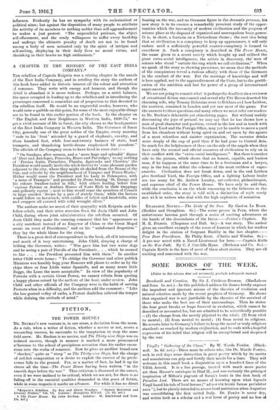A CHAPTER fl THE HISTORY OF THE EAST INDIA COMPANY.*
THE rebellion of Captain Keigwin was a stirring chapter in the annals of the East India Company, and in retelling the story the authors of this book have added to historic interest all the colour and attraction of romance. They write with energy and humour, and though the detail is abundant it is never tedious. Perhaps, on a strict balance, the space occupied in leading up to the rebellion and in introducing the personages concerned is somewhat out of proportion to that devoted to the rebellion itself. He would bo an ungrateful reader, however, who would raise a quibble on this point, for some of the most enjoyable things are to be found in this earlier portion of the book. In the chapter on " The English and their Neighbours in Western India, 1660-75," wo get a vivid account of life in Surat, the city chosen as the headquarters of the East India Company in Western India. The Governor of Surat City, generally one of tho great nobles of the Empire, every morning " rode to his ' Seat' attended by a guard of elephants, cavalry; and three hundred foot, while four-and-twenty banners of state, loud trumpets, and thundering kettle-drums emphasized his grandeur." The officials of the Company seem to have lived in some state :-
" On Sundays, after sermon, and a ' more large and splendid' dinner of '.Deer and Antelopes, Peacocks, Hares and Partridges,' to say nothing of ' Persian fruits, Pistachios, Plumbs, Apricocks and Cherries,' the President would usually invite the whole factory to some pleasant garden adjacent to the city, where they might sit shaded from the Beams of the Sun, and refresht by the neighbourhood of Tongues and Water-Works.' Hither would come the President and his Lady in Palanquins, with a noise of Trumpets' and preceded by Peons bearing St. George and his colours Swallow-tailed in Silk,' with others leading liefore him ' curious Persian or Arabian Horses of State Rich in their trappings and gallantly equipt • ; next to him would come the members of Council in large coaches drawn by a pair of stately Oxen,' while the factors would follow on horseback, with saddles of velvet and headstalls, reins and cruppers all covered with solid wrought silver."
The authors make no secret of their sympathy with Keigwin and his fellow-rebels, and their utter aversion from Sir Josia Child and John Child, during whose joint administration the rebellion occurred. Of Josia Child they make the amusing comment that his " appearance as a city merchant instead of as Emperor of China or the Great Mogul Seeps an error of Providence," and on his "uninformed despotism" they lay the whole blame for the rising.
There is a great deal of correspondence in the book, all of it interesting and much of it very entertaining. John Child, denying a charge of bribing the Governor, writes : " Wee gave him but two water dogs and he seeing a pair of Pistol's of the Presidents . . . which ho seemed to like . . . the President presented 'him with them." In another letter Child wrote home : " To oblidge the Governor and other publick Ministers wee humbly begg your Honours will please to order us by the ships three or four Little water Spaniells, and as many neato little Doggs, the Lease the more acceptable." In view of the popularity of Pretests with a certain Great Power, we cannot refrain from quoting a happy phrase coined by the authors of the book under review. John Child and other officials of the Company were in tho habit of serving Protests when in a difficulty, and the authors add the comment : " Like the less genteel volley of oaths, a Protest doubtless relieved the temper while defining the attitude of mind."


































 Previous page
Previous page